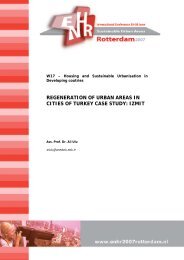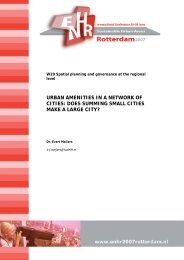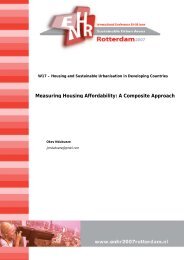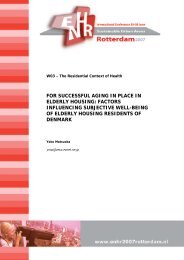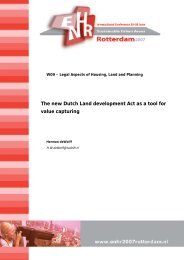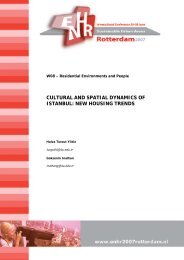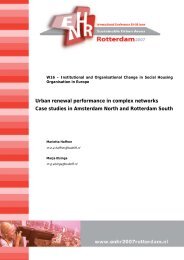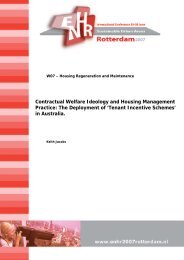what about the spatial dimension of subsidiarity in housing policy?
what about the spatial dimension of subsidiarity in housing policy?
what about the spatial dimension of subsidiarity in housing policy?
Create successful ePaper yourself
Turn your PDF publications into a flip-book with our unique Google optimized e-Paper software.
W02 – Migration, Residential Mobility, and Hous<strong>in</strong>g<br />
Policy<br />
WHAT ABOUT THE SPATIAL DIMENSION OF<br />
SUBSIDIARITY IN HOUSING POLICY?<br />
Roland Goetgeluk<br />
R.W.Goetgeluk@tudelft.nl<br />
Tom de Jong<br />
T.deJong@geo.uu.nl
What <strong>about</strong> <strong>the</strong> <strong>spatial</strong> <strong>dimension</strong> <strong>of</strong> <strong>subsidiarity</strong> <strong>in</strong> hous<strong>in</strong>g <strong>policy</strong>?<br />
ENHR 2007 International Conference on ‘Susta<strong>in</strong>able Urban Areas’<br />
What <strong>about</strong> <strong>the</strong> <strong>spatial</strong> <strong>dimension</strong> <strong>of</strong> <strong>subsidiarity</strong> <strong>in</strong> hous<strong>in</strong>g <strong>policy</strong>?<br />
Roland Goetgeluk<br />
OTB Research Institute for Hous<strong>in</strong>g, Urban and Mobility Studies<br />
Delft University <strong>of</strong> Technology, r.w.goetgeluk@tudelft.nl<br />
+31 15 278 2876, +31 15 278 4422<br />
Tom de Jong<br />
Faculty Geosciences<br />
Utrecht University, t.dejong@geo.uu.nl<br />
+31 30 253 1393, +31 30 253 2037<br />
Keywords: hous<strong>in</strong>g <strong>policy</strong>, town & country plann<strong>in</strong>g, migration patterns, <strong>spatial</strong> cluster<strong>in</strong>g,<br />
<strong>in</strong>tramax, modifiable area problem<br />
Abstract: This paper addresses two related questions. Do our statistical <strong>spatial</strong> data suit our<br />
<strong>the</strong>oretical and <strong>policy</strong> models? Do our present <strong>spatial</strong> organizations <strong>of</strong> municipalities and<br />
prov<strong>in</strong>ces match <strong>the</strong> pr<strong>in</strong>ciple <strong>of</strong> <strong>subsidiarity</strong> <strong>in</strong> Dutch hous<strong>in</strong>g <strong>policy</strong> and Town & Country<br />
Plann<strong>in</strong>g? Subsidiarity refers to <strong>the</strong> concept that any central authority should only performed<br />
tasks which cannot be performed effectively at a more immediate or local level. Us<strong>in</strong>g a valid<br />
<strong>spatial</strong> level given <strong>the</strong> goal (function) is at stake. For nearly 30 years <strong>the</strong> Dutch M<strong>in</strong>istry <strong>of</strong><br />
Hous<strong>in</strong>g, Spatial Plann<strong>in</strong>g & <strong>the</strong> Environment uses a fixed classification <strong>of</strong> hous<strong>in</strong>g market<br />
regions. They are used <strong>the</strong> calculate <strong>in</strong>dexes on migration, affordability, home ownership,<br />
hous<strong>in</strong>g shortages et cetera over time. For o<strong>the</strong>r <strong>policy</strong> goals, such as Urban Restructur<strong>in</strong>g,<br />
data collected at ZIP-codes <strong>of</strong> adm<strong>in</strong>istrative areas like neighborhoods, are used to rank<br />
neighborhoods. The results are used to def<strong>in</strong>e new <strong>policy</strong> goals and/or <strong>in</strong>struments. However,<br />
are <strong>the</strong> <strong>spatial</strong> level <strong>of</strong> <strong>the</strong> analyses and <strong>the</strong> <strong>policy</strong> measures justified? Last years, we proved<br />
that <strong>the</strong> <strong>spatial</strong> <strong>dimension</strong> <strong>of</strong> hous<strong>in</strong>g markets regions and neighborhoods change significantly<br />
over time. Last year we used <strong>the</strong> <strong>of</strong>ficial def<strong>in</strong>ition <strong>of</strong> hous<strong>in</strong>g market regions to def<strong>in</strong>e a<br />
simple goal function, to select valid data and an INTRAMAX cluster technique to trace<br />
<strong>spatial</strong> patterns <strong>in</strong> <strong>in</strong>ter-municipal migration 1990 en 2000. Now, we have extended <strong>the</strong><br />
analysis referr<strong>in</strong>g to <strong>subsidiarity</strong> <strong>in</strong> hous<strong>in</strong>g <strong>policy</strong>. We compare <strong>the</strong> <strong>of</strong>ficial adm<strong>in</strong>istrative<br />
level <strong>of</strong> <strong>the</strong> municipality and prov<strong>in</strong>ce with our functional INTRAMAX regions and <strong>the</strong> EU<br />
NUTS 1. We conclude that <strong>subsidiarity</strong> implies scal<strong>in</strong>g up municipalities and prov<strong>in</strong>ces.<br />
Therefore all k<strong>in</strong>ds <strong>of</strong> <strong>in</strong>dexes become less <strong>in</strong>formative. Unfortunately <strong>the</strong> impact on <strong>the</strong><br />
<strong>in</strong>dexes can not be shown because <strong>the</strong> <strong>of</strong>ficial report uses <strong>the</strong> criticized <strong>of</strong>ficial classification<br />
and <strong>the</strong> report has not been published.<br />
Workshop: W02: Migration, Residential Mobility and Hous<strong>in</strong>g Policy<br />
Authors: Roland Goetgeluk & Tom de Jong<br />
1
What <strong>about</strong> <strong>the</strong> <strong>spatial</strong> <strong>dimension</strong> <strong>of</strong> <strong>subsidiarity</strong> <strong>in</strong> hous<strong>in</strong>g <strong>policy</strong>?<br />
What <strong>about</strong> <strong>the</strong> <strong>spatial</strong> <strong>dimension</strong> <strong>of</strong> <strong>subsidiarity</strong> <strong>in</strong> hous<strong>in</strong>g<br />
<strong>policy</strong>?<br />
1. Introduction<br />
This contribution is <strong>the</strong> fourth <strong>in</strong> a row at <strong>the</strong> ENHR. It will be <strong>the</strong> last. They deal with <strong>the</strong><br />
‘modifiable area problem’ (Davies 2003, Isaaks & Mohan 1989) or <strong>the</strong> ecological fallacy<br />
problem (Blalock 1984). It means that every <strong>spatial</strong> classification must be directly l<strong>in</strong>ked to<br />
its goal s<strong>in</strong>ce a false classification under or overestimates a process or pattern. Do our<br />
statistical <strong>spatial</strong> data suit our <strong>the</strong>oretical and <strong>policy</strong> models?<br />
This paper addresses two related questions. Do our statistical <strong>spatial</strong> data suit our <strong>the</strong>oretical<br />
and <strong>policy</strong> models? Do our present <strong>spatial</strong> organizations <strong>of</strong> municipalities and prov<strong>in</strong>ces<br />
match <strong>the</strong> pr<strong>in</strong>ciple <strong>of</strong> <strong>subsidiarity</strong> <strong>in</strong> Dutch hous<strong>in</strong>g <strong>policy</strong> and Town & Country Plann<strong>in</strong>g?<br />
Subsidiarity refers to <strong>the</strong> concept that any central authority should only performed tasks<br />
which cannot be performed effectively at a more immediate or local level. Us<strong>in</strong>g a valid<br />
<strong>spatial</strong> level given <strong>the</strong> goal (function) is at stake.<br />
For nearly 30 years <strong>the</strong> Dutch M<strong>in</strong>istry <strong>of</strong> Hous<strong>in</strong>g, Spatial Plann<strong>in</strong>g & <strong>the</strong> Environment uses<br />
a fixed classification <strong>of</strong> hous<strong>in</strong>g market regions. They are used <strong>the</strong> calculate <strong>in</strong>dexes on<br />
migration, affordability, home ownership, hous<strong>in</strong>g shortages et cetera over time. For o<strong>the</strong>r<br />
<strong>policy</strong> goals, such as Urban Restructur<strong>in</strong>g, data collected at ZIP-codes <strong>of</strong> adm<strong>in</strong>istrative areas<br />
like neighborhoods, are used to rank neighborhoods. The results are used to def<strong>in</strong>e new <strong>policy</strong><br />
goals and/or <strong>in</strong>struments. However, are <strong>the</strong> <strong>spatial</strong> level <strong>of</strong> <strong>the</strong> analyses and <strong>the</strong> <strong>policy</strong><br />
measures justified? Last years, we proved that <strong>the</strong> <strong>spatial</strong> <strong>dimension</strong> <strong>of</strong> hous<strong>in</strong>g markets<br />
regions and neighborhoods change significantly over time.<br />
Last year we used <strong>the</strong> <strong>of</strong>ficial def<strong>in</strong>ition <strong>of</strong> hous<strong>in</strong>g market regions to def<strong>in</strong>e a simple goal<br />
function, to select valid data and an INTRAMAX cluster technique to trace <strong>spatial</strong> patterns <strong>in</strong><br />
<strong>in</strong>ter-municipal migration 1990 en 2000. Now, we have extended <strong>the</strong> analysis referr<strong>in</strong>g to<br />
<strong>subsidiarity</strong> <strong>in</strong> hous<strong>in</strong>g <strong>policy</strong>. We compare <strong>the</strong> <strong>of</strong>ficial adm<strong>in</strong>istrative level <strong>of</strong> <strong>the</strong><br />
municipality and prov<strong>in</strong>ce with our functional INTRAMAX regions and <strong>the</strong> EU NUTS1.<br />
We organized <strong>the</strong> contribution as follows. First we present <strong>the</strong> background on <strong>subsidiarity</strong> and<br />
<strong>the</strong> modifiable area problem. Second we deal with <strong>the</strong> methodology. Third, we show <strong>the</strong><br />
results. We <strong>in</strong>clude a summary <strong>of</strong> <strong>the</strong> results <strong>of</strong> 2006 and it serves as <strong>the</strong> context. The analysis<br />
is descriptive. We end with <strong>the</strong> conclusions. Unfortunately we were not allowed yet to present<br />
how <strong>the</strong> <strong>in</strong>dexes on migration, affordability, home ownership, hous<strong>in</strong>g shortages change if <strong>the</strong><br />
<strong>of</strong>ficial hous<strong>in</strong>g market classification and our INTRAMAX classification are used. The f<strong>in</strong>al<br />
reports on affordability, home ownership, hous<strong>in</strong>g shortages for <strong>the</strong> M<strong>in</strong>istry <strong>of</strong> Hous<strong>in</strong>g,<br />
Spatial Plann<strong>in</strong>g & <strong>the</strong> Environment are not published yet. A problem is that some studies use<br />
<strong>the</strong> INTRAMAX while o<strong>the</strong>rs use <strong>the</strong> <strong>of</strong>ficial classification.<br />
2. Subsidiarity<br />
Subsidiarity means that any central authority should only perform tasks, which cannot be<br />
performed effectively at a more immediate or local level 1 . The managerial and <strong>the</strong> <strong>spatial</strong><br />
scale <strong>of</strong> <strong>the</strong>se immediate and local levels should match to tackle problems. This means that a<br />
1 The concept has become widespread s<strong>in</strong>ce European Charter <strong>of</strong> Local Self-Government (1985), Treaty <strong>of</strong><br />
Maastricht (1992) and <strong>of</strong> course <strong>the</strong> Treaty establish<strong>in</strong>g a Constitution for Europe (2004).<br />
Workshop: W02: Migration, Residential Mobility and Hous<strong>in</strong>g Policy<br />
Authors: Roland Goetgeluk & Tom de Jong<br />
2
What <strong>about</strong> <strong>the</strong> <strong>spatial</strong> <strong>dimension</strong> <strong>of</strong> <strong>subsidiarity</strong> <strong>in</strong> hous<strong>in</strong>g <strong>policy</strong>?<br />
regularly <strong>the</strong> exist<strong>in</strong>g adm<strong>in</strong>istrative regionalization must be tested. We must try to falsify<br />
present classifications <strong>of</strong> immediate and local levels function <strong>in</strong>stead <strong>of</strong> confirm<strong>in</strong>g.<br />
Figure 1<br />
Borders <strong>of</strong> 12 Prov<strong>in</strong>ces, 370 municipalities and <strong>the</strong> municipal population size for<br />
2007<br />
Sources: Central Bureau <strong>of</strong> Statistic 2007<br />
Four democratic adm<strong>in</strong>istrative levels play an important role hous<strong>in</strong>g <strong>policy</strong>, hous<strong>in</strong>g<br />
construction plan/zon<strong>in</strong>g schemes and Town & Country Plann<strong>in</strong>g: Europe, <strong>the</strong> national<br />
government, <strong>the</strong> prov<strong>in</strong>ce and <strong>the</strong> municipality. Figure 1 shows <strong>the</strong> <strong>spatial</strong> <strong>dimension</strong>s <strong>of</strong> <strong>the</strong><br />
last three. The Prov<strong>in</strong>cial States, directly elected, elect <strong>the</strong>mselves <strong>the</strong> First Chamber. This<br />
Chamber resembles <strong>the</strong> House <strong>of</strong> Lords <strong>in</strong> <strong>the</strong> UK or <strong>the</strong> French Sénate. The Second Chamber<br />
<strong>of</strong> <strong>the</strong> National Parliament is elected directly. Before <strong>the</strong> rise <strong>of</strong> <strong>the</strong> K<strong>in</strong>gdom <strong>of</strong> <strong>the</strong><br />
Ne<strong>the</strong>rlands (1813 first Dutch K<strong>in</strong>g, 1814 first Constitution), <strong>the</strong> national parliament was<br />
based on representatives <strong>of</strong> <strong>the</strong> prov<strong>in</strong>ces. The prov<strong>in</strong>ce is <strong>the</strong> oldest adm<strong>in</strong>istrative level and<br />
<strong>the</strong>refore still strongly embedded <strong>in</strong> national law (New Constitution 1848). The prov<strong>in</strong>ces<br />
have not changed <strong>in</strong> shape and size. The municipalities have existed s<strong>in</strong>ce 1830 and have<br />
direct democratic chosen parliament. Before <strong>the</strong> rise <strong>of</strong> <strong>the</strong> K<strong>in</strong>gdom <strong>of</strong> <strong>the</strong> Ne<strong>the</strong>rlands, <strong>the</strong>y<br />
did not exit. The cities boards ruled and took part <strong>in</strong> <strong>the</strong> Staten (Staten) <strong>of</strong> <strong>the</strong> prov<strong>in</strong>ces. The<br />
state does exist a long time, but that nation-state exists s<strong>in</strong>ce <strong>the</strong> late 19 th century. The<br />
development <strong>of</strong> Europe leads to an erosion <strong>of</strong> <strong>the</strong> state <strong>in</strong> favor <strong>of</strong> Europe and <strong>the</strong> immediate<br />
and local level. However, is local <strong>the</strong> level <strong>of</strong> <strong>the</strong> municipality and immediate <strong>the</strong> prov<strong>in</strong>cial<br />
level? Back to <strong>the</strong> future?<br />
Is <strong>the</strong>re need to ask ourselves if adm<strong>in</strong>istrative levels and it <strong>spatial</strong> <strong>dimension</strong> function well?<br />
Yes! Many studies show mismatches between on one hand l<strong>in</strong>k<strong>in</strong>g goals <strong>of</strong> hous<strong>in</strong>g, labor<br />
market, transport, nature <strong>in</strong> Town & Countryside plann<strong>in</strong>g and on <strong>the</strong> o<strong>the</strong>r hand <strong>the</strong><br />
Workshop: W02: Migration, Residential Mobility and Hous<strong>in</strong>g Policy<br />
Authors: Roland Goetgeluk & Tom de Jong<br />
3
What <strong>about</strong> <strong>the</strong> <strong>spatial</strong> <strong>dimension</strong> <strong>of</strong> <strong>subsidiarity</strong> <strong>in</strong> hous<strong>in</strong>g <strong>policy</strong>?<br />
decentralization processes. Van der Wouden et al. (2006a) argue that <strong>the</strong>se mismatches have<br />
<strong>in</strong>creased: deregulation and decentralization to <strong>the</strong> commercial parties (project developers,<br />
hous<strong>in</strong>g corporations), lower level public organizations (prov<strong>in</strong>ces, municipalities) and<br />
centralization to <strong>the</strong> EU, have led fail<strong>in</strong>g supra local and supra prov<strong>in</strong>cial organization <strong>of</strong><br />
plann<strong>in</strong>g. Subsidiarity paradoxically demands up scal<strong>in</strong>g <strong>of</strong> <strong>the</strong> municipality (mergers) and<br />
prov<strong>in</strong>ces from a functional perspective.<br />
To solve <strong>the</strong> problem all k<strong>in</strong>ds <strong>of</strong> proposals have been made. The merg<strong>in</strong>g <strong>of</strong> municipalities is<br />
popular. There number <strong>of</strong> municipalities has decreased from 1430 (1830) to less than 400 <strong>in</strong><br />
2007 due to mergers. However <strong>of</strong>ten <strong>the</strong>y are not based on a functional nodal perspective.<br />
Mergers with<strong>in</strong> a conurbation (core city and <strong>the</strong> surround<strong>in</strong>g suburbs) are ra<strong>the</strong>r limited.<br />
Before 1813 <strong>the</strong> opposite would have been <strong>the</strong> case s<strong>in</strong>ce <strong>the</strong> countryside was free for<br />
annexation. The <strong>in</strong>troduction <strong>of</strong> <strong>the</strong> municipal level has eroded this functional cluster<strong>in</strong>g.<br />
Some legal form <strong>of</strong> cooperation between municipalities <strong>in</strong> large conurbations exits (WGR+,<br />
Law on Common Regulations Plus). However, <strong>the</strong>y lack democratic control and <strong>of</strong> course<br />
negotiations are difficult especially related to hous<strong>in</strong>g allowances, <strong>the</strong> <strong>spatial</strong> distribution <strong>of</strong><br />
new construction <strong>in</strong> <strong>the</strong> rental and owner-occupy<strong>in</strong>g sector. At <strong>the</strong> prov<strong>in</strong>cial level all k<strong>in</strong>ds<br />
<strong>of</strong> proposals have been made as well. A proposal is a collaboration <strong>of</strong> prov<strong>in</strong>ces (NUTS 2 2)<br />
<strong>in</strong>to 4 regions (NUTS 1). The advantage is that Dutch law with respect <strong>the</strong> First Chamber<br />
rema<strong>in</strong>s <strong>the</strong> same. A commission chaired by former Prime-M<strong>in</strong>ister Kok advocated a<br />
Randstad-Holland Prov<strong>in</strong>ce. However Ritsema Van Eck et al. (2006b) proved that <strong>the</strong><br />
Randstad-Holland is not a unity at all. Based on analysis <strong>of</strong> specialty, <strong>in</strong>tegration and<br />
complementary <strong>of</strong> flow data (work<strong>in</strong>g, leisure, shopp<strong>in</strong>g, f<strong>in</strong>ancial flow and firm l<strong>in</strong>kages),<br />
<strong>the</strong> Randstad-Holland still consists <strong>of</strong> heavenly specialized conurbations and does not<br />
function as a network city. Strange enough this study does not <strong>in</strong>clude migration flows as we<br />
have done so far.<br />
Many studies show that one size fits all does not exist and surely not over time. Logically<br />
chang<strong>in</strong>g <strong>the</strong> <strong>spatial</strong> <strong>dimension</strong>s <strong>of</strong> adm<strong>in</strong>istrative layers, let alone abolish<strong>in</strong>g <strong>the</strong>m, is difficult<br />
for legal arguments. But is this true for scientific and <strong>policy</strong> related research? We th<strong>in</strong>k not.<br />
At <strong>the</strong> present a number <strong>of</strong> studies for <strong>the</strong> M<strong>in</strong>istry <strong>of</strong> Hous<strong>in</strong>g, Spatial Plann<strong>in</strong>g & <strong>the</strong><br />
Environment are nearly ready. They deal with <strong>the</strong> development <strong>in</strong> time and space <strong>of</strong> <strong>in</strong>dexes<br />
on migration, affordability, home ownership, hous<strong>in</strong>g shortages et cetera. Most <strong>of</strong> <strong>the</strong>se<br />
studies use a fixed classification <strong>of</strong> hous<strong>in</strong>g market regions. The hous<strong>in</strong>g market region is <strong>the</strong><br />
area <strong>in</strong> which those on <strong>the</strong> demand side <strong>of</strong> <strong>the</strong> hous<strong>in</strong>g market are generally prepared to move<br />
house without this caus<strong>in</strong>g any unacceptable loss <strong>of</strong> social or cultural contacts or a change <strong>of</strong><br />
work” (DGVH 1982). In <strong>the</strong> hous<strong>in</strong>g market region most people move for hous<strong>in</strong>g related<br />
motives. Motives related to <strong>the</strong> household (cohabitation, divorce) and work/study careers are<br />
excluded. It makes sense s<strong>in</strong>ce hous<strong>in</strong>g related moves are expla<strong>in</strong>ed by peoples’ preferences<br />
and perceptions <strong>of</strong> social (social norms) and contextual (supply and regulation) structures<br />
(Azjen & Madden 1986). The o<strong>the</strong>r moves are necessary to realize non hous<strong>in</strong>g goals like<br />
cohabition, divorce or accept<strong>in</strong>g a job far away. So, only if <strong>the</strong> <strong>spatial</strong> classification is time<strong>in</strong>variant<br />
than <strong>the</strong> <strong>in</strong>dexes make sense.<br />
In <strong>the</strong> past we have shown that this classification is <strong>in</strong>valid. In this contribution we will show<br />
this as well. Unfortunately, we can not show how <strong>the</strong> <strong>of</strong>ficial classification leads to<br />
sometimes completely different results. Why? The f<strong>in</strong>al reports on affordability, home<br />
ownership, hous<strong>in</strong>g shortages for <strong>the</strong> M<strong>in</strong>istry <strong>of</strong> Hous<strong>in</strong>g, Spatial Plann<strong>in</strong>g & <strong>the</strong><br />
Environment are not published yet. This argument makes sense. The problem is that some <strong>of</strong><br />
<strong>the</strong>se studies use <strong>the</strong> INTRAMAX while o<strong>the</strong>rs use <strong>the</strong> <strong>of</strong>ficial classification. So, <strong>in</strong> this<br />
2 Nomenclature des Unités Territoriales Statistiques<br />
Workshop: W02: Migration, Residential Mobility and Hous<strong>in</strong>g Policy<br />
Authors: Roland Goetgeluk & Tom de Jong<br />
4
What <strong>about</strong> <strong>the</strong> <strong>spatial</strong> <strong>dimension</strong> <strong>of</strong> <strong>subsidiarity</strong> <strong>in</strong> hous<strong>in</strong>g <strong>policy</strong>?<br />
contribution we will predict <strong>what</strong> immediate size is needed from <strong>the</strong> perspective <strong>of</strong> <strong>the</strong><br />
prov<strong>in</strong>cial tasks. At <strong>the</strong> prov<strong>in</strong>cial level match<strong>in</strong>g demand and supply on <strong>the</strong> hous<strong>in</strong>g market<br />
for various motives for mov<strong>in</strong>g is at stake.<br />
3. Methodology<br />
Many studies on hous<strong>in</strong>g, migration, segregation, use statistical data collected at various<br />
<strong>spatial</strong> (adm<strong>in</strong>istrative) scales. For <strong>in</strong>stance, segregation and concentration are measured by<br />
means <strong>of</strong> G<strong>in</strong>i coefficients or multilevel regressions parameters. However, good models and<br />
good variables means noth<strong>in</strong>g if <strong>the</strong> <strong>spatial</strong> scale is fraud. In simple words: is a bad<br />
neighborhood everywhere bad and is a good neighborhood everywhere good? Goetgeluk &<br />
Wassenberg (2005) showed <strong>the</strong> logic beh<strong>in</strong>d <strong>the</strong> geo statistics. They test <strong>the</strong> assumption <strong>of</strong><br />
<strong>in</strong>tra-class homogeneity and <strong>in</strong>terclass heterogeneity for neighborhoods. Figure 2 shows how<br />
averages hide reality and how standard deviations hide <strong>the</strong> <strong>spatial</strong> patterns. However, <strong>in</strong><br />
comb<strong>in</strong>ation with Rook’s reality th<strong>in</strong>gs become clear. The cluster results <strong>of</strong> figure 2 would be<br />
different. Neighborhood A <strong>in</strong>deed would have been a merger <strong>of</strong> <strong>the</strong> four sub-areas. For <strong>the</strong><br />
neighborhoods B and C two pairs <strong>of</strong> clusters would emerge although <strong>the</strong>y would be different<br />
<strong>in</strong> shape: horizontal and diagonal. Unfortunately <strong>of</strong> geo statistics are ra<strong>the</strong>r unknown under<br />
social (<strong>spatial</strong>) scientists, except for those <strong>in</strong>volved <strong>in</strong> land use model<strong>in</strong>g and <strong>spatial</strong> economic<br />
model<strong>in</strong>g (Visser 2005, Wadell et al 2004). Some statistical basic knowledge might improve<br />
many studies s<strong>in</strong>ce it would reveal if ‘people suit our models’ (after Bio 2000). If <strong>the</strong><br />
‘rooksflight’ shows complexity, why not model <strong>the</strong> complexity?<br />
Figure 2<br />
How statistics may trigger our m<strong>in</strong>d<br />
Neighborhood A B C<br />
5 5 10 10 10 0<br />
5 5 0 0 0 10<br />
Mean 5,0 5,0 5,0<br />
Standarddeviation 0,0 5,0 5,0<br />
Rook's (<strong>spatial</strong> statistic) 1,0 0,5 0,0<br />
Source: Goetgeluk & Wassenberg, 2005<br />
Goetgeluk & Wassenberg (2005) also showed that <strong>the</strong> goal <strong>of</strong> a research is important for <strong>the</strong><br />
goal-function. Aga<strong>in</strong> we use <strong>the</strong> neighborhood. Accord<strong>in</strong>g to most people <strong>the</strong> neighborhood is<br />
<strong>of</strong>ten a priori <strong>the</strong> same as some adm<strong>in</strong>istrative area. If one is <strong>in</strong>terested <strong>in</strong> ‘Neighborhood<br />
satisfaction’ on should at least def<strong>in</strong>e <strong>what</strong> <strong>the</strong> neighborhood is. Figure 3 is reveal<strong>in</strong>g. The<br />
direct liv<strong>in</strong>g environment, which is based on <strong>the</strong> aggregate activity patterns <strong>of</strong> respondents,<br />
resembled <strong>the</strong> neighborhood, which was based on <strong>the</strong> aggregation <strong>of</strong> <strong>the</strong> <strong>in</strong>dividual polygons<br />
drawn by <strong>the</strong> respondents. This was nice result s<strong>in</strong>ce it showed that for people liv<strong>in</strong>g <strong>in</strong> a<br />
neighborhood <strong>the</strong> <strong>spatial</strong> scale is an expression <strong>of</strong> activities, networks and <strong>of</strong> course<br />
<strong>in</strong>formation people collect. Figure 3 shows how <strong>the</strong> patterns cross <strong>the</strong> adm<strong>in</strong>istrative boarders.<br />
In many municipal monitor<strong>in</strong>g systems ‘Neighborhood satisfaction’ is presented at this<br />
adm<strong>in</strong>istrative level.<br />
Workshop: W02: Migration, Residential Mobility and Hous<strong>in</strong>g Policy<br />
Authors: Roland Goetgeluk & Tom de Jong<br />
5
What <strong>about</strong> <strong>the</strong> <strong>spatial</strong> <strong>dimension</strong> <strong>of</strong> <strong>subsidiarity</strong> <strong>in</strong> hous<strong>in</strong>g <strong>policy</strong>?<br />
Figure 3 The heat maps for <strong>the</strong> direct liv<strong>in</strong>g environment (left) and <strong>the</strong> neighborhood (right)<br />
Utrecht overplayed by <strong>the</strong> zip code 4 (blue).<br />
Direct liv<strong>in</strong>g environment<br />
Neighborhood<br />
Source: Goetgeluk & Wassenberg, 2005<br />
Above examples can be generalized. We argue that <strong>in</strong> most cases any goal (function)<br />
demands for data collected at a lower <strong>spatial</strong> level and for different periods. The goal-function<br />
searches for clusters <strong>of</strong> <strong>the</strong>se lower level data. The result<strong>in</strong>g classification m<strong>in</strong>imizes <strong>the</strong><br />
summed ‘with<strong>in</strong> class’ variances and maximizes <strong>the</strong> ‘between class” variances for a specific<br />
goal. So, different <strong>policy</strong> goals demand for different goal functions and data <strong>in</strong> time and/or<br />
space. For statistical model<strong>in</strong>g a wrong classification leads to large standard errors <strong>of</strong> <strong>the</strong><br />
parameters estimates and bad model performance.<br />
For nearly 30 years Dutch Hous<strong>in</strong>g <strong>policy</strong> and Town & Country Plann<strong>in</strong>g use fixed<br />
classifications <strong>of</strong> hous<strong>in</strong>g market regions to compare <strong>in</strong>dexes on migration, affordability,<br />
home ownership, hous<strong>in</strong>g shortages over time. The hous<strong>in</strong>g market region is <strong>the</strong> area <strong>in</strong> which<br />
those on <strong>the</strong> demand side <strong>of</strong> <strong>the</strong> hous<strong>in</strong>g market are generally prepared to move house without<br />
this caus<strong>in</strong>g any unacceptable loss <strong>of</strong> social or cultural contacts or a change <strong>of</strong> work” (DGVH<br />
1982). In <strong>the</strong> hous<strong>in</strong>g market region most people move for hous<strong>in</strong>g related motives. Motives<br />
related to <strong>the</strong> household (cohabitation, divorce) and work/study careers are excluded. It makes<br />
sense s<strong>in</strong>ce hous<strong>in</strong>g related moves are expla<strong>in</strong>ed by peoples’ preferences and perceptions <strong>of</strong><br />
social (social norms) and contextual (supply and regulation) structures (Azjen & Madden<br />
1986). The o<strong>the</strong>r moves are necessary to realize non hous<strong>in</strong>g goals like cohabition, divorce or<br />
accept<strong>in</strong>g a job far away. So, only if <strong>the</strong> <strong>spatial</strong> classification is time-<strong>in</strong>variant than <strong>the</strong><br />
<strong>in</strong>dexes make sense. We showed that <strong>the</strong>y are time-variant.<br />
So, <strong>the</strong> <strong>in</strong>teraction between municipalities is a measure for <strong>the</strong> functional distance. High<br />
levels <strong>of</strong> <strong>in</strong>teraction <strong>in</strong>dicate a short functional distance. Hence, <strong>the</strong> cluster<strong>in</strong>g <strong>of</strong><br />
municipalities that are close <strong>in</strong> terms <strong>of</strong> functional distance will lead to <strong>the</strong> creation <strong>of</strong><br />
functional regions. If this cluster<strong>in</strong>g is based on residential movement flows, it will lead to <strong>the</strong><br />
demarcation <strong>of</strong> hous<strong>in</strong>g market regions, as <strong>the</strong>y exist <strong>in</strong> practice. Of course <strong>the</strong> clusters reflect<br />
revealed choices. This expla<strong>in</strong> why such functional clusters are so vital for monitor<strong>in</strong>g and<br />
calculation <strong>of</strong> <strong>the</strong> <strong>in</strong>dexes <strong>of</strong> affordability, home ownership and hous<strong>in</strong>g shortages for <strong>the</strong><br />
M<strong>in</strong>istry <strong>of</strong> Hous<strong>in</strong>g, Spatial Plann<strong>in</strong>g & The Environment. Space moulds. Four steps are<br />
necessary. S<strong>in</strong>ce we use <strong>the</strong> same data as last year we<br />
Workshop: W02: Migration, Residential Mobility and Hous<strong>in</strong>g Policy<br />
Authors: Roland Goetgeluk & Tom de Jong<br />
6
What <strong>about</strong> <strong>the</strong> <strong>spatial</strong> <strong>dimension</strong> <strong>of</strong> <strong>subsidiarity</strong> <strong>in</strong> hous<strong>in</strong>g <strong>policy</strong>?<br />
1. Estimate <strong>the</strong> share <strong>of</strong> moves related to <strong>the</strong> three motives for mov<strong>in</strong>g by distance<br />
We used <strong>the</strong> WBO’s 1989/90 and 2002. The WBO started <strong>in</strong> <strong>the</strong> late seventies as a substitute<br />
for <strong>the</strong> National Population and Hous<strong>in</strong>g Census. S<strong>in</strong>ce 1977, every four years between <strong>the</strong><br />
50.000 and 70.000 persons answers questions <strong>of</strong> <strong>the</strong>ir past, present and <strong>in</strong>tended hous<strong>in</strong>g<br />
situation. Approximately 20 percent <strong>of</strong> <strong>the</strong> household moves per two year or 1,2 million<br />
households <strong>of</strong> 2 million person 18 years or older. We used <strong>the</strong> weight factor ‘Person’ <strong>of</strong> <strong>the</strong><br />
WBO s<strong>in</strong>ce <strong>the</strong> migration matrix (step 2) refers to people. For <strong>the</strong> descriptive analysis we<br />
used <strong>the</strong> weight factor ‘households’. We estimated <strong>the</strong> relationship between distance, age and<br />
<strong>the</strong> motive for mov<strong>in</strong>g. Distance <strong>in</strong> km is a straight l<strong>in</strong>e between <strong>the</strong> geographical center<br />
po<strong>in</strong>ts (x, y) <strong>of</strong> municipalities. If people move with<strong>in</strong> a municipality <strong>the</strong> distance is zero. We<br />
recoded this distances <strong>in</strong>to 5 Km classes (weighted average). We used <strong>the</strong> categories 18-34,<br />
34-54, 55 and older. Age is a proxy for <strong>the</strong> comb<strong>in</strong>ed effect <strong>of</strong> events <strong>in</strong> <strong>the</strong> related<br />
study/work, household and hous<strong>in</strong>g careers. We have four motives for mov<strong>in</strong>g: ‘Hous<strong>in</strong>g’,<br />
‘Household’ and ‘Work/Study’ and ‘O<strong>the</strong>r reasons’. This last motive shows a distance decay<br />
that resembles, which is similar to one <strong>of</strong> hous<strong>in</strong>g and household. We distributed ‘O<strong>the</strong>r<br />
reasons’ over <strong>the</strong>se two classes.<br />
2. Prepare <strong>the</strong> <strong>in</strong>ter-municipal person matrix<br />
The migration matrixes are for free and handled by <strong>the</strong> national Central Bureau Statistics. The<br />
migration periods are 1988-1990 and 2000-2002. These periods were chosen to l<strong>in</strong>k <strong>the</strong>m to<br />
<strong>the</strong> WBO’s 89/90 and 2002. We took <strong>the</strong> average flow to account for yearly fluctuations. The<br />
migration flow is one-year age group specific. We made four separate matrices: total, 18-34,<br />
35-54, 55+. The square migration matrix consists <strong>of</strong> a diagonal, which reflect <strong>the</strong> <strong>in</strong>tramunicipal<br />
migration, while <strong>the</strong> two triangles above and below <strong>the</strong> diagonal reflect <strong>the</strong> <strong>in</strong>- an<br />
out migration. The diagonal, <strong>in</strong>tra municipal moves, is empty. This may have an impact (step<br />
3). For each pair <strong>of</strong> municipalities <strong>the</strong> crow-flight distance is calculated and classified <strong>in</strong>to 5<br />
km classes. F<strong>in</strong>ally we splitted each <strong>of</strong> <strong>the</strong> four matrices up accord<strong>in</strong>g <strong>the</strong> three motives for<br />
mov<strong>in</strong>g (step 1). For he analyses <strong>of</strong> 2007 we only used <strong>the</strong> ‘total’ matrices for each motive for<br />
mov<strong>in</strong>g <strong>in</strong> a cumulative way: hous<strong>in</strong>g motive (base), base + household motive (base X) and<br />
base X + study/work (total).<br />
3. Determ<strong>in</strong>e <strong>spatial</strong> patterns for each <strong>in</strong>ter-municipal migration matrix (2006 & 2007)<br />
We used one <strong>of</strong> several well-known methods for cluster<strong>in</strong>g on functional distance: Intramax-<br />
Analysis (Masser & Scheurwater, 1977). It is a well-tested method (see for overview<br />
flowmap.geog.uu.nl). The proportional amount <strong>of</strong> <strong>in</strong>teraction with<strong>in</strong> a group is maximized <strong>in</strong><br />
each step <strong>of</strong> <strong>the</strong> procedure. In our case, at each step <strong>of</strong> <strong>the</strong> merger process between all <strong>the</strong><br />
rema<strong>in</strong><strong>in</strong>g separate areas, <strong>the</strong> two areas are merged that have <strong>the</strong> strongest relative<br />
relationship <strong>in</strong> terms <strong>of</strong> people mov<strong>in</strong>g house. This means that two areas are grouped on <strong>the</strong><br />
basis <strong>of</strong> <strong>the</strong> maximization <strong>of</strong> <strong>the</strong> follow<strong>in</strong>g target function:<br />
Imax=Tij / (Oi * Dj) + Tij / (Dj * Oi)<br />
In which:<br />
Tij = <strong>in</strong>teraction between orig<strong>in</strong> area i and dest<strong>in</strong>ation area j<br />
Oi = Σj Tij<br />
Dj = Σi Tij<br />
The <strong>in</strong>teraction between each pair <strong>of</strong> municipalities (T) is divided by <strong>the</strong> product <strong>of</strong> <strong>the</strong> sum<br />
per row and column. The formula reveals a strong familiarity to chi-square based measures.<br />
The Intramax is a stepwise hierarchical procedure: N areas are grouped <strong>in</strong> N-1 steps. The total<br />
<strong>in</strong>trazonal flow is zero at N areas, and 100% at 1 (N-(N-1)) areas. In each step <strong>in</strong>ter-zonal<br />
flows (<strong>in</strong> and out) become <strong>in</strong>tra-zonal. Based on <strong>the</strong> def<strong>in</strong>ition <strong>of</strong> <strong>the</strong> hous<strong>in</strong>g market region<br />
Workshop: W02: Migration, Residential Mobility and Hous<strong>in</strong>g Policy<br />
Authors: Roland Goetgeluk & Tom de Jong<br />
7
What <strong>about</strong> <strong>the</strong> <strong>spatial</strong> <strong>dimension</strong> <strong>of</strong> <strong>subsidiarity</strong> <strong>in</strong> hous<strong>in</strong>g <strong>policy</strong>?<br />
<strong>the</strong> stop-criterion is 75% <strong>in</strong>tra-zonal migration. For <strong>the</strong> comparison for 1990 and 2002 we<br />
used this criterion. For <strong>the</strong> present analyses we apply also an new criterion: 12 prov<strong>in</strong>ces. We<br />
deal with <strong>spatial</strong> data and we cluster <strong>spatial</strong>ly. We applied Intramax <strong>in</strong> <strong>the</strong> free GIS-package<br />
FlOWMAP. This GIS is Flowmap(flowmap.geog.uu.nl).<br />
4. Compare <strong>the</strong> maps and conclude<br />
By means <strong>of</strong> overlay <strong>in</strong> GIS <strong>the</strong> ra<strong>the</strong>r simple maps can be compared by sight <strong>in</strong>stead <strong>of</strong> all<br />
k<strong>in</strong>ds <strong>of</strong> sophisticated statistics (Visser 2005).<br />
The f<strong>in</strong>al step is to use <strong>the</strong> new classification to calculate <strong>the</strong> <strong>in</strong>dexes <strong>of</strong> affordability, home<br />
ownership and hous<strong>in</strong>g shortages.<br />
4. Does <strong>the</strong> <strong>of</strong>ficial hous<strong>in</strong>g market classification suit our<br />
hous<strong>in</strong>g <strong>policy</strong> <strong>in</strong>dicator efforts?<br />
The age group 18-34 is twice as large (650,000 persons) as <strong>the</strong> next age group (3.40,000<br />
persons) and more than three time as large as <strong>the</strong> 55+ (180.000 persons). Most people move<br />
until 10 km. The average ‘search area’ is 80 km 2 or 0.23% <strong>of</strong> <strong>the</strong> whole <strong>of</strong> Dutch area.<br />
Figure 4 shows <strong>the</strong> relative flows per distance class per motive for mov<strong>in</strong>g <strong>in</strong> 1989/90 en<br />
200/2002. The distance decay has changed: long distance moves occur more <strong>of</strong>ten <strong>in</strong> 2002.<br />
This distance decay pattern is different for <strong>the</strong> various age groups. The age group 18-34<br />
moves more <strong>of</strong>ten for household and work/study related motives. The general conclusion is<br />
that most age groups just move over longer distances than <strong>in</strong> <strong>the</strong> past.<br />
Our f<strong>in</strong>d<strong>in</strong>gs are supported by o<strong>the</strong>r studies: Eastern, Nor<strong>the</strong>rn and Sou<strong>the</strong>rn regions become<br />
more attractive. Partially <strong>the</strong> hous<strong>in</strong>g prices and shortages <strong>in</strong> <strong>the</strong> West expla<strong>in</strong> this. For<br />
teleworkers, consultants and pr<strong>of</strong>essional commuters, such locations are suitable. We know<br />
that people accept longer commut<strong>in</strong>g times (Geurs 2006, Hilbers et al. 2004, Van Ham 2002).<br />
Return migration <strong>of</strong> elderly might be an explanation for <strong>the</strong> age-group 55+. At this very<br />
moment a specific Hous<strong>in</strong>g Need Survey by <strong>the</strong> M<strong>in</strong>istry <strong>of</strong> Hous<strong>in</strong>g, Spatial Plann<strong>in</strong>g & <strong>the</strong><br />
Environment (WoON Ouderen Module) is focus<strong>in</strong>g on this age group. The age-specific,<br />
motive specific distance decay functions reveal <strong>the</strong>mselves also <strong>in</strong> <strong>the</strong> INTRAMAX clusters<br />
(figure 5).<br />
Figure 5 shows that <strong>the</strong> <strong>of</strong>ficial classification really makes no sense even without <strong>the</strong><br />
INTRAMAX. Its <strong>in</strong>ternal logic fails. For <strong>in</strong>stance <strong>the</strong> smallest region is Gron<strong>in</strong>gen<br />
(Gron<strong>in</strong>gen is yellow <strong>in</strong> <strong>the</strong> North). This region equals <strong>the</strong> municipality and <strong>the</strong> city <strong>of</strong><br />
Gron<strong>in</strong>gen. Gron<strong>in</strong>gen is a primate city <strong>in</strong> <strong>the</strong> North-east. Although it has many relationships<br />
with it surround<strong>in</strong>g municipalities <strong>in</strong> <strong>the</strong> prov<strong>in</strong>ce <strong>of</strong> Gron<strong>in</strong>gen and Dren<strong>the</strong>, <strong>the</strong> relationships<br />
between small remote municipalities dom<strong>in</strong>ate <strong>in</strong> <strong>the</strong> North. The Rotterdam region consists <strong>of</strong><br />
many more cities and villages. In <strong>the</strong> analysis <strong>of</strong> <strong>in</strong>dexes Gron<strong>in</strong>gen will boost earlier than<br />
Rotterdam only because <strong>of</strong> its size. The INTRAMAX shows <strong>the</strong> opposite. Indeed <strong>the</strong> number<br />
<strong>of</strong> moves <strong>in</strong> <strong>the</strong> North demands for a larger area than <strong>in</strong> <strong>the</strong> Rotterdam area. The city <strong>of</strong><br />
Gron<strong>in</strong>gen functions <strong>in</strong>deed as one <strong>of</strong> <strong>the</strong> few cores where people work, bit not housed.<br />
Workshop: W02: Migration, Residential Mobility and Hous<strong>in</strong>g Policy<br />
Authors: Roland Goetgeluk & Tom de Jong<br />
8
What <strong>about</strong> <strong>the</strong> <strong>spatial</strong> <strong>dimension</strong> <strong>of</strong> <strong>subsidiarity</strong> <strong>in</strong> hous<strong>in</strong>g <strong>policy</strong>?<br />
Figure 4 Distance decay by motive <strong>in</strong> relative numbers for 1989/90 and 2002<br />
Sources: Goetgeluk 1997/adapted, WBO 2002/OTB<br />
The region Rotterdam is <strong>in</strong>terest<strong>in</strong>g <strong>in</strong> comparison with <strong>the</strong> Amsterdam region. Rotterdam is<br />
more or less comparable <strong>in</strong> all three classifications. The reason is that Rotterdam and Den<br />
Haag (The Hague) are part <strong>of</strong> <strong>the</strong> sou<strong>the</strong>rn w<strong>in</strong>g <strong>of</strong> <strong>the</strong> Randstad-Holland. This w<strong>in</strong>g is not<br />
economically boom<strong>in</strong>g at all. The nor<strong>the</strong>rn part is. This results <strong>in</strong> hous<strong>in</strong>g shortages, sky-high<br />
prices and <strong>the</strong>refore forced moves. Hence, <strong>the</strong> Amsterdam functional region has changed<br />
between 1990 and 2000.<br />
We draw <strong>the</strong> conclusion that <strong>the</strong> <strong>of</strong>ficial classification may not be used for research activities<br />
s<strong>in</strong>ce it from <strong>the</strong> perspective <strong>of</strong> <strong>subsidiarity</strong> it is wrong. Fur<strong>the</strong>r we argue that <strong>the</strong> local level is<br />
not <strong>the</strong> municipality, but at least a level higher. Especially <strong>in</strong> <strong>the</strong> west this is true.<br />
Figure 5<br />
Comparison <strong>of</strong> <strong>the</strong> Intramax hous<strong>in</strong>g market regions for 1990 and 2000 and <strong>the</strong><br />
<strong>of</strong>ficial 31 and <strong>the</strong> urban structure <strong>in</strong> <strong>the</strong> Ne<strong>the</strong>rlands<br />
1990 Functional 2002 Functional<br />
Workshop: W02: Migration, Residential Mobility and Hous<strong>in</strong>g Policy<br />
Authors: Roland Goetgeluk & Tom de Jong<br />
9
What <strong>about</strong> <strong>the</strong> <strong>spatial</strong> <strong>dimension</strong> <strong>of</strong> <strong>subsidiarity</strong> <strong>in</strong> hous<strong>in</strong>g <strong>policy</strong>?<br />
Official 31<br />
Urban pattern<br />
Sources: WBO 1989/90 and 2002/OTB<br />
5. Search<strong>in</strong>g for <strong>the</strong> right size<br />
If <strong>the</strong> local level must resemble <strong>the</strong> hous<strong>in</strong>g market region, than <strong>the</strong> prov<strong>in</strong>cial level might be<br />
suboptimal too. Figure 6 shows <strong>the</strong> match between <strong>the</strong> INTRAMAX hous<strong>in</strong>g market regions<br />
and <strong>the</strong> prov<strong>in</strong>ces. Different patterns occur. For <strong>in</strong>stance <strong>the</strong> functional hous<strong>in</strong>g market region<br />
<strong>of</strong> Utrecht (14) nearly consists <strong>of</strong> <strong>the</strong> whole prov<strong>in</strong>ce <strong>of</strong> Utrecht. Also o<strong>the</strong>r patterns exist:<br />
hous<strong>in</strong>g market 1 (Gron<strong>in</strong>gen) consist <strong>of</strong> nearly two prov<strong>in</strong>ces. We conclude that <strong>the</strong> prov<strong>in</strong>ce<br />
will face more and more opposition from larger conurbations, which have more power ei<strong>the</strong>r<br />
because <strong>of</strong> mergers or special legal power like <strong>the</strong> WGR+ (Law on Common Regulations<br />
Workshop: W02: Migration, Residential Mobility and Hous<strong>in</strong>g Policy<br />
Authors: Roland Goetgeluk & Tom de Jong<br />
10
What <strong>about</strong> <strong>the</strong> <strong>spatial</strong> <strong>dimension</strong> <strong>of</strong> <strong>subsidiarity</strong> <strong>in</strong> hous<strong>in</strong>g <strong>policy</strong>?<br />
Plus.) This will become even more problematic s<strong>in</strong>ce <strong>the</strong> new law on Town and Country<br />
Plann<strong>in</strong>g (WRO) will reduce <strong>the</strong> controll<strong>in</strong>g power <strong>of</strong> <strong>the</strong> prov<strong>in</strong>ce more.<br />
Figure 6<br />
Comparison <strong>of</strong> <strong>the</strong> Intramax hous<strong>in</strong>g market regions 2002 with <strong>the</strong> <strong>of</strong>ficial prov<strong>in</strong>cial<br />
classification and <strong>the</strong> urban pattern<br />
a: Color: prov<strong>in</strong>cial borders<br />
b: Black/numbers: Intramax hous<strong>in</strong>g market regions 2002<br />
Sources: WBO 2002/OTB<br />
If it does not fit, <strong>what</strong> size would be useful? In our first test <strong>the</strong> number <strong>of</strong> 12 prov<strong>in</strong>ces is<br />
fixed. S<strong>in</strong>ce chang<strong>in</strong>g <strong>the</strong> constitution is not so easy, it makes sense to have 12 prov<strong>in</strong>ces.<br />
Only if that does not work, we may question if twelve prov<strong>in</strong>ces are needed. Some legal<br />
collaboration like <strong>the</strong> WGR+ might be useful and practical for legal reasons. Ano<strong>the</strong>r option<br />
is chang<strong>in</strong>g <strong>the</strong> constitution.<br />
Figure 7 shows that 12 prov<strong>in</strong>ces do not suit our ideas beh<strong>in</strong>d <strong>subsidiarity</strong>. The Ne<strong>the</strong>rlands is<br />
a country <strong>of</strong> conurbations as figure 1 and 5 already showed. In many <strong>in</strong>stances <strong>the</strong> prov<strong>in</strong>ces<br />
are equal to <strong>the</strong> hous<strong>in</strong>g market regions. More important is that <strong>the</strong> maps show large<br />
differences <strong>in</strong> <strong>the</strong> way people are distributed over space for <strong>the</strong> three motives for mov<strong>in</strong>g.<br />
Most Dutchmen will recognize <strong>the</strong> <strong>spatial</strong> patterns immediately. In accordance to <strong>the</strong> study <strong>of</strong><br />
Ritsema Van Eck et al. (2006b) all functional maps show that <strong>the</strong> Randstad-Holland is not a<br />
unity at all. Often <strong>the</strong> Randstad-Holland is split up <strong>in</strong>to <strong>the</strong> North W<strong>in</strong>g (Haarlem-<br />
Amsterdam-Utrecht) and <strong>the</strong> South W<strong>in</strong>g (Den Haag-Rotterdam). We agree that <strong>the</strong><br />
Randstad-Holland sounds nice, but <strong>in</strong> reality does not exist at all. So, former prime-m<strong>in</strong>ister<br />
Kok may be wrong (see section 2).<br />
Figure 7<br />
Comparison <strong>of</strong> <strong>the</strong> 12 <strong>in</strong>tramax and <strong>the</strong> <strong>of</strong>ficial prov<strong>in</strong>cial classification on basis <strong>of</strong><br />
various flows <strong>of</strong> migration<br />
Workshop: W02: Migration, Residential Mobility and Hous<strong>in</strong>g Policy<br />
Authors: Roland Goetgeluk & Tom de Jong<br />
11
What <strong>about</strong> <strong>the</strong> <strong>spatial</strong> <strong>dimension</strong> <strong>of</strong> <strong>subsidiarity</strong> <strong>in</strong> hous<strong>in</strong>g <strong>policy</strong>?<br />
Only hous<strong>in</strong>g related motives<br />
Hous<strong>in</strong>g + household<br />
Hous<strong>in</strong>g + household + works/study<br />
Sources: WBO 2002/OTB<br />
Prov<strong>in</strong>cial classification<br />
Workshop: W02: Migration, Residential Mobility and Hous<strong>in</strong>g Policy<br />
Authors: Roland Goetgeluk & Tom de Jong<br />
12
What <strong>about</strong> <strong>the</strong> <strong>spatial</strong> <strong>dimension</strong> <strong>of</strong> <strong>subsidiarity</strong> <strong>in</strong> hous<strong>in</strong>g <strong>policy</strong>?<br />
Figure 8<br />
Comparison <strong>of</strong> <strong>the</strong> 3 <strong>in</strong>tramax ‘hous<strong>in</strong>g market regions’, <strong>the</strong> NUTS 1 classification on<br />
basis <strong>of</strong> various flows <strong>of</strong> migration<br />
Only hous<strong>in</strong>g related motives<br />
Hous<strong>in</strong>g + household<br />
Hous<strong>in</strong>g + household + works/study<br />
Sources: WBO 2002/OTB<br />
NUTS 1 classification<br />
Workshop: W02: Migration, Residential Mobility and Hous<strong>in</strong>g Policy<br />
Authors: Roland Goetgeluk & Tom de Jong<br />
13
What <strong>about</strong> <strong>the</strong> <strong>spatial</strong> <strong>dimension</strong> <strong>of</strong> <strong>subsidiarity</strong> <strong>in</strong> hous<strong>in</strong>g <strong>policy</strong>?<br />
Interest<strong>in</strong>g is <strong>the</strong> recruit<strong>in</strong>g area for household formation is some<strong>what</strong> different that <strong>the</strong> areas<br />
for hous<strong>in</strong>g and labor. Romance has its own space, but <strong>in</strong> <strong>the</strong> end all romance need is a ro<strong>of</strong><br />
and food. The labor and hous<strong>in</strong>g market even structure were we love.<br />
Figure 8 shows <strong>the</strong> alternative stop-criterion: 75% <strong>in</strong>trazonal. We added <strong>the</strong> NUT1<br />
classification <strong>of</strong> <strong>the</strong> EU. For those who are bit familiar with <strong>the</strong> logics beh<strong>in</strong>d <strong>the</strong> geography<br />
<strong>of</strong> our history <strong>the</strong> outcome is strik<strong>in</strong>g. Figure 9 shows <strong>the</strong> Ne<strong>the</strong>rlands around 1500 and<br />
around 1648 when <strong>the</strong> Republic <strong>of</strong> <strong>the</strong> Seven Prov<strong>in</strong>ces was formally accepted (Treaty <strong>of</strong><br />
Munster). The second map shows <strong>the</strong> orig<strong>in</strong> <strong>of</strong> our prov<strong>in</strong>ces, which were <strong>of</strong> Feudal (Holland)<br />
or <strong>the</strong> Diocese <strong>of</strong> Utrecht. The last had many economic relations with <strong>the</strong> Nor<strong>the</strong>rn prov<strong>in</strong>ces.<br />
This old cluster<strong>in</strong>g has had a decisive impact on <strong>the</strong> economic, social and <strong>spatial</strong> organization<br />
<strong>of</strong> <strong>the</strong> Ne<strong>the</strong>rlands. In <strong>the</strong> 12 th and <strong>the</strong> 13 th <strong>the</strong> present urban structure was carefully planned<br />
for economic, political and military reasons (Rutte 2002). Only <strong>in</strong> <strong>the</strong> late 19 th and 20 th new<br />
cities and <strong>the</strong> nation-state were carefully planned. Old structures do no vanish that easy.<br />
Figure 9 The organization <strong>of</strong> <strong>the</strong> Ne<strong>the</strong>rlands between 1380 and 1648<br />
The Republic <strong>of</strong> & Prov<strong>in</strong>ces and Spanish Flanders at<br />
Between 1400-1500, before Carolus V<br />
<strong>the</strong> Treaty <strong>of</strong> Munster 1648<br />
Source: Vermaseren Beknopte Atlas der algemene en vaderlandse geschiedenis.<br />
This implies that a prov<strong>in</strong>cial classification may be old, but that <strong>the</strong> larger clusters are much<br />
more older. Given <strong>the</strong> development <strong>of</strong> <strong>the</strong> EU (ACED 2007), <strong>in</strong> which <strong>the</strong> <strong>subsidiarity</strong><br />
process results <strong>in</strong> less power for <strong>the</strong> nation states <strong>in</strong> favor for on one hand Europe, <strong>the</strong> Council<br />
and so on and <strong>the</strong> o<strong>the</strong>r hand <strong>the</strong> regions, look<strong>in</strong>g back to <strong>the</strong> future makes sense for <strong>the</strong><br />
prov<strong>in</strong>ces.<br />
Of course our INTRAMAX map based on al migration flows <strong>the</strong> first map will never be<br />
accepted. The prov<strong>in</strong>ce <strong>of</strong> Utrecht would never accept a separation form <strong>the</strong> Randstad-<br />
Holland and especially Amsterdam. Political reasons have <strong>the</strong>ir functionality as well. But at<br />
least we show that collaboration between prov<strong>in</strong>ces makes sense.<br />
Workshop: W02: Migration, Residential Mobility and Hous<strong>in</strong>g Policy<br />
Authors: Roland Goetgeluk & Tom de Jong<br />
14
What <strong>about</strong> <strong>the</strong> <strong>spatial</strong> <strong>dimension</strong> <strong>of</strong> <strong>subsidiarity</strong> <strong>in</strong> hous<strong>in</strong>g <strong>policy</strong>?<br />
6. Back to <strong>the</strong> future?<br />
The modifiable areas problem has a direct relationship between functional regions and <strong>the</strong><br />
concept <strong>of</strong> <strong>subsidiarity</strong>. In studies that deal with place and space researchers and <strong>policy</strong>makers<br />
should be aware <strong>of</strong> <strong>the</strong> risk <strong>of</strong> ecological fallacies. One risk is us<strong>in</strong>g <strong>spatial</strong> data that is<br />
more and more available. However, is this data suitable for our model<strong>in</strong>g? One basic rule is<br />
that <strong>the</strong> <strong>spatial</strong> level op <strong>the</strong> <strong>in</strong>put must be much lower than <strong>the</strong> <strong>spatial</strong> level we want to<br />
expla<strong>in</strong>. Fur<strong>the</strong>r we argued that <strong>the</strong> <strong>spatial</strong> level must be l<strong>in</strong>ked to <strong>the</strong> objective <strong>of</strong> a research<br />
or <strong>policy</strong> question. Show<strong>in</strong>g <strong>the</strong> risk <strong>of</strong> this k<strong>in</strong>d <strong>of</strong> fallacy was <strong>the</strong> goal <strong>of</strong> this contribution.<br />
We used an example l<strong>in</strong>ked to migration, residential mobility and hous<strong>in</strong>g <strong>policy</strong>. We showed<br />
that <strong>the</strong> present classification would result <strong>in</strong> <strong>in</strong>valid <strong>in</strong>dicators. In a more general sense many<br />
<strong>policy</strong> papers and research unjustly assume that <strong>the</strong> data used as a specific <strong>spatial</strong> scale is<br />
valid. This is a mistake. The core <strong>of</strong> research deal<strong>in</strong>g with migration, hous<strong>in</strong>g choice and<br />
hous<strong>in</strong>g <strong>policy</strong> should always test if <strong>the</strong> <strong>spatial</strong> scale fits <strong>the</strong> objective and <strong>the</strong>refore <strong>the</strong> goals<br />
function. Neighborhood may even not exist if <strong>the</strong> <strong>spatial</strong> scale is fraud. The message is: One<br />
Size Fits Noth<strong>in</strong>g or many Data do not suit our models.<br />
The f<strong>in</strong>al reports on affordability, home ownership, hous<strong>in</strong>g shortages for <strong>the</strong> M<strong>in</strong>istry <strong>of</strong><br />
Hous<strong>in</strong>g, Spatial Plann<strong>in</strong>g & <strong>the</strong> Environment are not published yet. A problem is that some<br />
studies use <strong>the</strong> INTRAMAX while o<strong>the</strong>rs use <strong>the</strong> <strong>of</strong>ficial classification. After <strong>the</strong>ir<br />
publication we will extend this contribution and publish it. Sometimes researchers <strong>in</strong>volved <strong>in</strong><br />
<strong>policy</strong> research sometimes have a split personality.<br />
References<br />
ACED (2007), The way forward for <strong>the</strong> European Union; A new treaty and supplementary Protocols.<br />
Contribution to <strong>the</strong> debate on Europe’s political prospects <strong>in</strong> <strong>the</strong> perspective <strong>of</strong> <strong>the</strong> European Council <strong>of</strong><br />
21-22 June 2007. Brussels: Action Committee for European Democracy, 4th June<br />
Azjen, I. & T.J. Madden (1986), Prediction <strong>of</strong> goal-oriented behavior: attitudes, <strong>in</strong>tentions and perceived,<br />
behavioral control. Journal <strong>of</strong> Experimental Social Psychology, 22, pp. 453-474.<br />
Bio, A. F. (2000), Does vegetation suit our model; data and model assumptions and <strong>the</strong> assessment <strong>of</strong> species<br />
distribution <strong>in</strong> space. Utrecht: Faculty <strong>of</strong> Geographical Sciences. PhD. Dissertation.<br />
Blalock, H. M. (1984), Basic Dilemmas <strong>in</strong> <strong>the</strong> Social Sciences. Beverly Hills: Sage Publications.<br />
Davies, B. (2003), Choos<strong>in</strong>g a method for poverty mapp<strong>in</strong>g. Rome: FAO.<br />
De Jong, T. (2006), flowmap.geog.uu.nl.<br />
DGVH (1982), won<strong>in</strong>gbouwprogrammer<strong>in</strong>g, een nadere uitwerk<strong>in</strong>g, deel 2: won<strong>in</strong>gmarktgebieden<br />
[Programm<strong>in</strong>g Hous<strong>in</strong>g Construction, hous<strong>in</strong>g market regions]. Den Haag: M<strong>in</strong>isterie van VROM.<br />
Dutch Centre for Political Participation, 2007), http://www.publiek-politiek.nl/<br />
Geurs, K. (2006), Accessibility, Land Use and Transport, accessibility evaluation <strong>of</strong> land-use and transport<br />
developments and <strong>policy</strong> strategies. Delft: Eburon. Ph.D. Dissertation.<br />
Goetgeluk, R. & T. De Jong (2005), Migration Analysis as a Political Instrument, The case <strong>of</strong> <strong>the</strong> Leiden and<br />
Bulb regions <strong>in</strong> Randstad Holland. In: R. Goetgeluk & S. Musterd (eds.), Beyond Residential Mobility,<br />
l<strong>in</strong>k<strong>in</strong>g residential choice with urban change. Open House International, Vol. No. 3. pp. 75-81.<br />
Goetgeluk, R. & T. De Jong (2006), Dynamic cluster <strong>in</strong> migration patterns: Intramax-analysies <strong>of</strong> <strong>in</strong>termunicipal<br />
migration flows between 1990-2004. Ljubljana: paper presented at <strong>the</strong> ENHR conference<br />
2006, Slovenia.<br />
Goetgeluk, R. (1997), Bomen over wonen: won<strong>in</strong>gmarktonderzoek met besliss<strong>in</strong>gsbomen [Trad<strong>in</strong>g <strong>of</strong>f Hous<strong>in</strong>g<br />
Preferences: hous<strong>in</strong>g market research with decision plan nets]. Utrecht: Utrecht University (PhD<br />
dissertation).<br />
Hilbers, H., J. Ritsema Van Eck & D. Snellen (2004), Behalve de dagelijkse files, over betrouwbaarheid van<br />
reistijd [Except <strong>the</strong> Daily Traffic Jams, deal<strong>in</strong>g with <strong>the</strong> confidence levels <strong>of</strong> travel time]. Den Haag:<br />
Ruimtelijk Planbureau.<br />
Isaaks, E.H. & R. Mohan Srivastava (1989), Applied Geostatistics. New York: Oxford University Press.<br />
Jókövi, M., C. Boon & F. Filius (2006), Won<strong>in</strong>gproductie ten tijde van VINEX, een verkenn<strong>in</strong>g [Hous<strong>in</strong>g<br />
Construction <strong>in</strong> <strong>the</strong> VINEX-Era, an exploration. Den Haag: Ruimtelijk Planbureau.<br />
Workshop: W02: Migration, Residential Mobility and Hous<strong>in</strong>g Policy<br />
Authors: Roland Goetgeluk & Tom de Jong<br />
15
What <strong>about</strong> <strong>the</strong> <strong>spatial</strong> <strong>dimension</strong> <strong>of</strong> <strong>subsidiarity</strong> <strong>in</strong> hous<strong>in</strong>g <strong>policy</strong>?<br />
Maat, K., J.J. Harts, M. Zeijmans van Emmichhoven & R. Goetgeluk (2005), Dynamiek van Stedelijke Milieus<br />
1996 – 2002 [Dynamics <strong>of</strong> Urban Hous<strong>in</strong>g Milieus]. Den Haag: M<strong>in</strong>istry VROM.<br />
Masser, F.I. and J. Scheurwater (1977). Een aggregatie methode voor ruimtelijke <strong>in</strong>teractiegegevens. [An<br />
aggregation method for <strong>spatial</strong> <strong>in</strong>teraction data]. In: Plann<strong>in</strong>g, methodiek en toepass<strong>in</strong>g 2, pp 3-9.<br />
Mulder, C.H. (1993), Migration dynamics: a life course approach. Amsterdam: Faculteit der Ruimtelijke<br />
Wetenschappen, Universiteit van Amsterdam, Thesis publishers/PDOD (PhD Dissertation).<br />
Oort, F. van, J. van Brussel, O. Raspe, M. Burger, J. van D<strong>in</strong>teren & B. van der Knaap (2006), Economische<br />
Netwerken <strong>in</strong> de region [Economic Networks <strong>in</strong> <strong>the</strong> region]. Den Haag: Ruimtelijk Planbureau.<br />
Ritsema van Eck, J.R., F. van Oort, O. Raspe, F. daalhuizen & J. van Brussel (2006), Vele steden maken nog<br />
geen Randstad [ Many Cities does not yet imply <strong>the</strong> Randstad-Holland]. Den Haag: Ruimtelijk<br />
Planbureau.<br />
Rutte, R. (2002), Stedenpolitiek en stadsplann<strong>in</strong>g <strong>in</strong> de lage landen 12e en 13e eeuwe[Urban politics and Urbvan<br />
Plann<strong>in</strong>g <strong>in</strong> <strong>the</strong> Low Countries: 12th and 13th centuries}. Zutphen: Wallburg Pers. Pd. Dissertation.<br />
Van Ham, M. (2002), Job access, workplace mobility and occupational achievement. Delft: Eburon Publishers<br />
(Ph.D. dissertation).<br />
Vermaseren, B.A. (1964), Beknopte atlas der algemene en vaderlandse geschiedenis [Concise Atlas <strong>of</strong> <strong>the</strong><br />
general and national history]. Gron<strong>in</strong>gen: P. Noordh<strong>of</strong>f.<br />
Visser, H. (2004), Te The MAP COMPARISON KIT:methods, s<strong>of</strong>tware and applications. Bilthoven: RIVM,<br />
report RIVM report 550002005/2004<br />
Waddell, P., A. Born<strong>in</strong>g, M.Noth, N. Freier, M. Becke & G. Ulfarsson (2004), Microsimulation <strong>of</strong> Urban<br />
Development and Location Choices: Design and Implementation <strong>of</strong> UrbanSim. Networks and Spatial<br />
Economics, Vol. 3 No. 1, pp. 43--67.<br />
Wassenberg, F., M. Arnoldus, R. Goetgeluk, F. Penn<strong>in</strong>ga & L. Re<strong>in</strong>ders (2006), Hoe breed is de buurt,<br />
typologie van woonmilieus: herkenbaar, bruikbaar en beschikbaar [How large is <strong>the</strong> neighborhood;<br />
typology <strong>of</strong> milieus: recognizability, usefulness and availability]. Delft: OTB-Research Institute for<br />
Hous<strong>in</strong>g, Urban and Mobility Studies, Delft University <strong>of</strong> Technology. Report M<strong>in</strong>istry <strong>of</strong> VROM.<br />
(www.vrom.nl).<br />
Wouden, R. van de, F. van Dam, D. Evers, A. hendriks, A. van Hoorn, N. Pieterse & G. Renes (2006),<br />
Verkenn<strong>in</strong>g van de ruimte 2006; ruimtelijk beleid tussen overheid en markt [Explor<strong>in</strong>g space 2006;<br />
<strong>spatial</strong> <strong>policy</strong> <strong>in</strong> between <strong>the</strong> state and market]. Den Haag: Ruimtelijk Planbureau.<br />
.<br />
Workshop: W02: Migration, Residential Mobility and Hous<strong>in</strong>g Policy<br />
Authors: Roland Goetgeluk & Tom de Jong<br />
16



